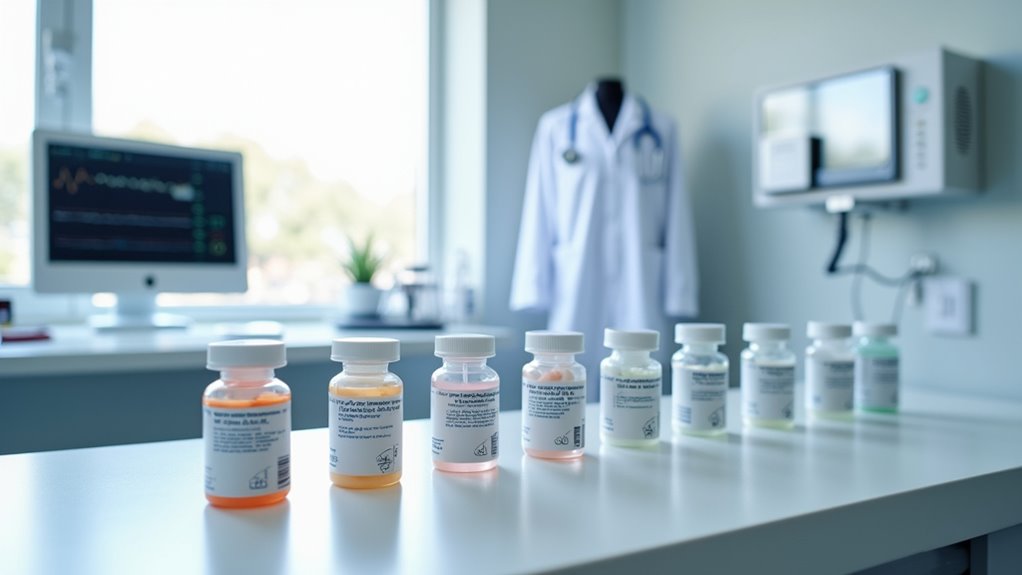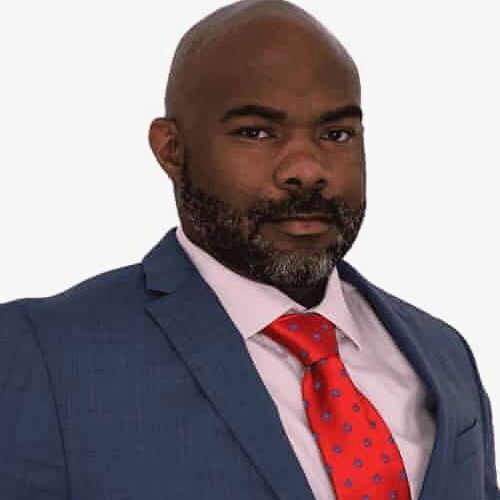The seven most effective addiction recovery programs you’ll find in 2025 combine evidence-based treatments: medical detoxification (75% initial recovery rate), residential treatment (65% completion rate), medication-assisted treatment (MAT) with 4.44x better retention, intensive outpatient programs, dual diagnosis care for co-occurring conditions, behavioral therapy approaches like CBT, and holistic recovery programs. Each approach offers unique advantages, with research showing ideal outcomes when treatments are integrated. Understanding these programs’ specific benefits will help you make informed decisions about your recovery process.
Medical Detox: The Essential First Step in Recovery

Three critical components define medical detoxification as the foundational primary step in addiction recovery.
To begin, evidence-based detox protocols guarantee safe withdrawal management through 24/7 medical supervision and medication-assisted treatment. Detox programs costing between $250 and $800 per day provide essential medical care and monitoring.
Second, specialized medical detox benefits include reduced withdrawal symptoms, decreased relapse risk, and management of co-occurring conditions. Like other chronic diseases such as diabetes and hypertension, addiction shows relapse rates of 40-60% when not properly managed through medical supervision. With 43.7 million Americans needing substance use treatment, professional medical detox remains a crucial gateway to recovery.
Third, supportive therapies complement the physiological stabilization process.
Current recovery statistics demonstrate the effectiveness of professional medical detox, with 75% of individuals achieving initial recovery according to CDC data.
Furthermore, SAMHSA reports 70% of patients show improved outcomes when starting their recovery process with supervised medical detoxification.
This structured approach addresses both the physical and psychological aspects of substance dependence, creating a solid foundation for subsequent treatment phases.
Residential Treatment: Full Immersion for Lasting Change

Residential treatment programs provide extensive, immersive recovery experiences that consistently demonstrate high success rates for lasting sobriety. The residential benefits include 24/7 supervision, structured daily routines, and continuous peer support within a therapeutic community setting.
Within this immersive environment, you’ll receive intensive evidence-based therapies, including cognitive behavioral therapy and integrated mental health services. Program completion rates typically exceed 65%, with many participants maintaining abstinence for 9+ months post-treatment. Recent data shows that residential non-hospital treatment is available in 24% of all treatment facilities nationwide. Integrating family therapy during treatment can increase abstinence rates by approximately 6%.
The structured setting proves particularly effective, as 80% of residents report improved quality of life.
Recovery housing programs further improve long-term outcomes by providing stable living environments and ongoing support systems. This thorough approach addresses both addiction and lifestyle factors, creating a solid foundation for sustained recovery and reduced relapse rates.
Medication-Assisted Treatment (MAT): Science-Based Recovery Solutions

Medication-Assisted Treatment’s proven success rates, including a 33% reduction in opioid-positive tests and 4.44 times greater treatment retention, demonstrate its effectiveness as a scientifically validated recovery approach.
Your MAT program options include FDA-approved medications such as methadone, buprenorphine, and naltrexone, each designed to address specific aspects of addiction and withdrawal. Recent evidence-based approaches have expanded treatment accessibility through Medicaid coverage. Regular healthcare provider monitoring ensures your treatment plan stays optimized as you progress through recovery.
When you combine these medications with behavioral therapy and counseling, you’ll receive a thorough treatment approach that addresses both the physiological and psychological components of addiction recovery. For pregnant women, reduced neonatal symptoms and shorter hospital stays have been documented when MAT is properly administered during treatment.
Evidence Behind MAT Success
Scientific evidence demonstrates that MAT stands as one of the most effective approaches for treating opioid use disorder, with studies consistently showing dramatic improvements in patient outcomes.
You’ll find that MAT effectiveness is proven through compelling statistics: it cuts overdose death rates by at least half and quadruples treatment retention compared to non-MAT approaches. The evidence shows participants are 4.44 times more likely to remain in recovery programs.
Despite clear data supporting MAT accessibility, fewer than 20% of individuals with opioid use disorder receive this treatment due to systemic barriers. Using a combination of FDA-approved medications alongside counseling provides comprehensive treatment for lasting recovery.
The approach not merely reduces infectious disease transmission through decreased injection drug use but also enables social reintegration through improved employment rates and family reunification.
Research confirms MAT’s success in breaking addiction cycles while addressing both physical dependence and behavioral components.
Modern MAT Medication Options
Modern pharmacological interventions for addiction treatment have evolved considerably, offering evidence-based solutions through carefully selected medications that target specific neurobiological mechanisms.
FDA-approved medications demonstrate proven medication efficacy in treating both opioid and alcohol use disorders. For OUD, methadone acts as a full agonist, while buprenorphine provides a partial agonist effect with lower abuse potential. Naltrexone blocks opioid receptors entirely, available in both oral and injectable forms. Research shows that individuals receiving methadone or buprenorphine are 50% less likely to experience a fatal overdose.
Treatment accessibility has expanded through office-based prescribing options for buprenorphine, while specialized clinics remain necessary for methadone administration. Medical detox is often required as the initial stabilization phase before beginning these medications.
For AUD, acamprosate normalizes brain chemistry, disulfiram creates adverse reactions to alcohol consumption, and naltrexone reduces alcohol’s reinforcing effects.
These medications, combined with behavioral therapy, form extensive treatment protocols supporting long-term recovery success.
Combining MAT With Therapy
The integration of behavioral therapies with pharmacological interventions represents a thorough approach to addiction recovery, demonstrating superior outcomes compared to single-modality treatments. Through integrated support and therapy engagement, you’ll benefit from a detailed treatment model that addresses both physiological and psychological aspects of addiction. Research shows that combining CBT with MAT helps improve long-term recovery outcomes. Evidence indicates that patients receiving methadone treatment are 33% less likely to test positive for opioid use.
| Treatment Component | Recovery Impact |
|---|---|
| CBT + MAT | 75% reduction in overdose risk |
| Family Therapy | Rebuilt support networks |
| Mental Health Care | Manages co-occurring disorders |
| Contingency Management | Reinforces positive behaviors |
| Aftercare Planning | Prevents post-treatment relapse |
This combined approach improves your recovery potential through neurobiological stabilization while developing essential coping strategies. You’ll experience improved treatment retention, reduced criminal activity, and better employment opportunities. The structured counseling system reinforces medication adherence while addressing distorted thought patterns, creating a strong foundation for sustained recovery.
Intensive Outpatient Programs: Flexibility Meets Structured Support
Maintaining a delicate balance between flexibility and structured support, Intensive Outpatient Programs (IOPs) represent an essential bridge between full inpatient care and traditional outpatient services.
By offering flexible scheduling while adhering to structured routines, IOPs allow you to maintain work and family commitments during recovery.
These programs address critical needs, as over 54.2 million Americans require substance use treatment annually.
You’ll find an extensive network of support through the 17,353 facilities nationwide offering IOP services.
The projected industry growth to $53 billion by 2025 reflects increasing demand and accessibility of these programs.
Research shows that mindfulness-based interventions have significantly improved outcomes for those in outpatient treatment programs.
The structured yet adaptable nature of IOPs provides an effective middle ground, combining regular therapeutic interventions with the ability to practice recovery skills in real-world settings.
With only 23% of individuals receiving the treatment they need, IOPs help bridge this significant treatment gap.
This balanced approach supports sustainable, long-term recovery outcomes.
Dual Diagnosis Care: Addressing Mental Health and Addiction Together
While IOPs provide structured support for addiction recovery, extensive treatment often requires addressing mental health conditions simultaneously. Research shows nearly 50% of individuals with substance use disorders have co-occurring mental health conditions, yet only 7.4% receive proper integrated care for both issues. With over seven million Americans currently facing dual diagnoses, the need for comprehensive treatment has never been more urgent.
Today’s dual diagnosis programs emphasize trauma-informed care and personalized treatment plans that target both conditions concurrently. You’ll find these programs particularly effective because they address root causes rather than treating disorders in isolation.
Through evidence-based approaches like CBT and peer support groups, you’re better equipped to manage overlapping symptoms and prevent relapse. Despite challenges in accessing coordinated care due to provider shortages and insurance limitations, specialized dual diagnosis treatment has become essential for achieving lasting recovery in 2025.
Behavioral Therapy Approaches: Rewiring the Brain for Sobriety
CBT’s evidence-based approach transforms your recovery patterns by teaching you to identify and challenge negative thoughts that trigger substance use, with studies showing its effectiveness across multiple substance use disorders.
You’ll learn practical skills through DBT to regulate emotions and build distress tolerance, creating a foundation for long-term emotional stability in recovery. Recent integration of mindfulness practices has significantly enhanced the effectiveness of these therapeutic approaches. Research shows that contingency management programs offering rewards for negative drug tests can significantly improve treatment outcomes.
These behavioral therapies work together to rewire neural pathways, replacing maladaptive coping mechanisms with healthy responses to stress and cravings. New government-funded projects are integrating technology with traditional behavioral therapies to enhance treatment outcomes and provide more comprehensive support for addiction recovery.
CBT Transforms Recovery Patterns
Research demonstrates that Cognitive Behavioral Therapy (CBT) greatly transforms addiction recovery patterns, producing a 42% response rate compared to 19% in control groups. Through cognitive restructuring techniques, you’ll strengthen neural pathways associated with self-regulation and impulse control, addressing the root causes of addictive behaviors.
CBT’s effectiveness extends across diverse substance use disorders, with studies showing 61.38% remission rates post-treatment and 75% at 6-month follow-up. Since multiple treatment attempts are often necessary, CBT provides a sustainable framework for ongoing recovery work. You’ll experience lasting changes through targeted relapse prevention strategies that modify automatic responses to addiction-related triggers.
The therapy maintains significant effect sizes (g=0.74 at 6-9 months), though you’ll need ongoing support to sustain recovery. CBT’s structured approach adapts well to varied settings, from individualized sessions to group formats, while requiring minimal resources compared to pharmacological interventions.
DBT Builds Emotional Stability
Through systematic emotional regulation training, Dialectical Behavior Therapy (DBT) revolutionizes addiction recovery by targeting the neurological basis of substance dependence.
You’ll develop emotional resilience through four core components: mindfulness for trigger awareness, emotion regulation for reduced vulnerability, distress tolerance for crisis management, and interpersonal effectiveness for boundary setting.
Research demonstrates DBT’s remarkable impact, with studies showing a 40% reduction in emotional dysregulation and 64% improvement in stability among patients.
You’ll learn essential coping strategies that reduce cravings by 30% during stressful moments while decreasing relapse risk by 35%.
The therapy’s effectiveness extends to dual diagnosis cases, particularly benefiting those with borderline personality disorder and substance use disorders.
DBT’s thorough approach helps you build sustainable recovery through improved emotional awareness and practical crisis-management techniques.
Holistic Recovery Programs: Healing Mind, Body, and Spirit
Holistic recovery programs represent a thorough approach to addiction treatment by addressing the interconnected dimensions of physical, emotional, spiritual, social, and intellectual wellness. Research using the WHOQOL-BREF assessment tool demonstrates significant improvements across all quality-of-life dimensions when implementing extensive healing strategies.
You’ll experience transformation through mindful practices that integrate physical exercise, nutritional guidance, and psychological counseling. These evidence-based techniques build emotional resilience while strengthening social connections through community support networks.
The program’s spiritual growth component helps you develop meaning and purpose beyond substance use, while cognitive development activities improve your decision-making abilities.
This integrated approach yields higher success rates compared to single-focus treatments, as demonstrated in recent studies. Your recovery process encompasses both traditional therapeutic methods and holistic healing practices, creating a sustainable foundation for long-term sobriety.
Frequently Asked Questions
How Much Do Insurance Companies Typically Cover for Addiction Recovery Programs?
Your insurance coverage for addiction recovery programs will vary considerably based on your specific policy and provider.
While most insurers offer some level of substance abuse treatment coverage, you’ll find that coverage limits and policy variations differ widely.
You’ll need to contact your insurance provider directly to determine exact benefits, as they may cover anywhere from 0-100% of costs depending on your plan and the type of treatment selected.
What Percentage of People Maintain Sobriety After Completing These Programs?
Based on clinical data, you’ll find varying success rates for maintaining sobriety after treatment completion.
Research shows approximately 76% of participants remain sober at 3 months, with 69% maintaining sobriety at 6 months.
Long-term sobriety rates indicate 70% sustained abstinence at 9 months post-treatment.
Your chances of success increase considerably when you combine medication-assisted therapy with counseling and maintain structured support for 12+ months after program completion.
Can Family Members Participate in Recovery Program Activities?
Yes, you’ll find extensive opportunities for family involvement in recovery programs.
Most treatment centers actively encourage family participation through specialized therapy sessions, educational workshops, and support groups. You can engage in family counseling, multi-family therapy sessions, and structured visitation programs.
These support systems help rebuild trust, improve communication, and strengthen family bonds during recovery. Moreover, you’ll have access to community-based resources like Al-Anon that specifically support family members.
Are There Age Restrictions for Different Types of Addiction Recovery Programs?
You’ll find that addiction recovery programs typically follow specific developmental stage guidelines based on developmental needs and legal requirements.
Most adult programs serve those 18 and older, while specialized youth programs cater to adolescents aged 12-17.
Some facilities offer young adult programs (18-25) that address unique challenges of this developmental stage group.
Detox and residential programs often have stricter developmental stage requirements due to medical considerations, while peer support groups may accommodate wider developmental stage ranges.
How Long Is the Typical Waiting List for Entering These Programs?
You’ll find waiting list durations vary considerably based on program type and accessibility factors.
For outpatient services, you might wait 1-2 weeks, while residential programs typically require 2-4 weeks.
If you’re seeking specialized treatment like MAT or dual diagnosis care, expect longer waits of 4-8 weeks.
You can reduce these times by considering multiple facilities, having insurance pre-approval ready, or exploring private-pay options.
Emergency medical detox usually offers immediate placement.






